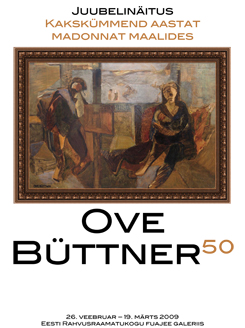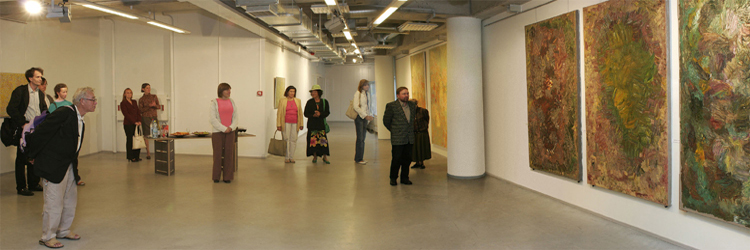An exhibition in the Foyer Gallery of the National Library of Estonia from the 26th of February up to the 19th of March 2009
 Ove Büttner has participated in exhibitions since 1987. But twenty years ago in 1988 he first presented to the public his work “Painting Madonna” at the exhibition of the Group T under the Tallinn Song Festival Grounds.
Ove Büttner has participated in exhibitions since 1987. But twenty years ago in 1988 he first presented to the public his work “Painting Madonna” at the exhibition of the Group T under the Tallinn Song Festival Grounds.
This year Ove Büttner celebrates his fiftieth summers. The exposition in the Foyer Gallery of the National Library of Estonia inaugurates the series of his jubelee exhibitions in Tallinn and in Tartu. The exhibition is on one hand retrospective and, on the other hand, covers his more recent works.
It is hard to summarise Ove’s creation in a few words, as being a personality who has vast knowledge in the history of painting and thorough experience in painting techniques he has experimented with various techniques to convey his message.
Vappu Thurlow: “Büttner - that is, first and foremost, colour, and only then an idea or a word, meanings and associations that the public can freely generate.” (Eesti Ekspress, 2005, 14.09.)
Johannes Saar:“ One can state that Ove Büttner's artistic world is an oasis of harmony within the schizophrenia of contemporary art. Why not! We really find here neither glamorous gesture nor stressed ambition, but a thorough synthesis of traditional painting brush techniques - from glazing to pointillism../ / Brainless colour idyll will break as a bubble, if a viewer, having been overwhelmed by anxiety, bows to read the titles of Ove Büttner's enormously large canvases.” (Vikerkaar, 1992/2)
The best example to characterise Ove Büttner’s social nerve is his canvas “Arearea” that he painted in one night in 1991 when the attempt to take by assault Toompea castle, the site of Estonian parliament took place. The fragments of this work speak for themselves.
Andri Ksenofontov has analysed the Seurat-like pointillistic period of Ove Büttner as the following: “The spotted raster of four-color print that overflows us from every journal, pixel screen and bus stop advertisement has deepened the understanding of a dot as the element of painting technique, manner or method. Ove's painting is rather the whole synthesised from the dots as elementary particles. Like art deco in National Romantic monumental and applied arts that followed the formation of new historical associations, being at the same time their background or model. Or the harmony of mosaics of the Byzantine art that have been stowed out of the pieces of glass and stone. /.../ The dots, first and foremost, seize with movement. Ove presents a microscopic photo of the butterfly wing that consists of separate colourful plaques set along the aerodynamic lines of the wing. They take a grip already before the beginning of the flight. In this way, the dots are the atoms of the soul that imbibe into the vortex.” (Sirp, 2005, 9.09.)
Ove Büttner has treated biblical thematics among other themes since he painted his “Resurrection” in 1988 and ending for now with his recent series of paintings “The Creatures Go to the Holy Top”. However, these paintings have not been directly produced for sanctuaries, but give hint of the artist’s attitude towards life.
Juta Kivimäe has said the following about Ove’s paintings: “Painting is a closed world that, relieved of the tyranny of perspective and illumination, has become the world of fairies, where nymphs and pans and the space around them is just marked. It helps to grasp the conditionality of our perception. There, where we believe to be massivity, we find transparency and, instead of heavy shadows, the light.”
Tiina Vilberg
